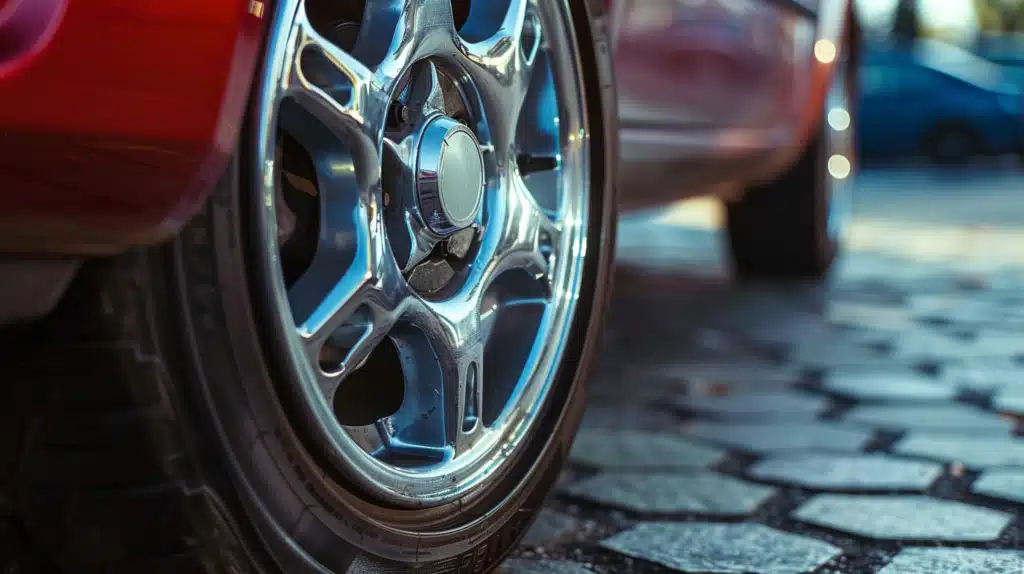Are you tired of spending hours at the mechanic’s shop for a simple wheel alignment? You’re not alone.
Many car owners are worried about the alignment process, fearing it will consume their entire day. But what if we told you that a wheel alignment shouldn’t be lengthy?
In fact, with a few expert tips, you can significantly reduce the time it takes to align your wheels.
Imagine returning to the road quickly, with a smoother ride and improved fuel efficiency.
The question on everyone’s mind is, “how long does an alignment take?”
In this article, we’ll reveal the insider secrets to help you answer that question and save time and money on your next alignment appointment.
Get ready to transform your alignment experience and enjoy a hassle-free ride!
What Is Wheel Alignment, and What Does It Do?

Wheel alignment is the process of adjusting the angles of your vehicle’s wheels to be perpendicular to the ground and parallel to each other.
This involves fine-tuning the suspension components that connect the wheels to the vehicle, ensuring proper tire contact with the road surface.
The three main angles adjusted during alignment are camber, toe, and caster.
Camber:
- Camber refers to the inward or outward tilt of the wheel when viewed from the front of the vehicle.
- Positive camber means the top of the wheel is tilted outward, while negative camber means the top is tilted inward.
- Proper camber ensures even tire wear and optimal handling.
Toe:
- The toe is the angle of the wheels about the vehicle’s longitudinal axis when viewed from above.
- Toe-in means the front of the wheels points slightly inward, while toe-out means pointing slightly outward.
- Correct toe alignment helps prevent rapid tire wear and ensures straight, stable driving.
Caster:
- Caster is the angle of the steering axis about the vertical when viewed from the side of the vehicle.
- Positive caster means the top of the steering axis is tilted toward the car’s rear, while negative caster means it’s tilted toward the front.
- Proper caster alignment helps with straight-line stability and steering returnability after turns.
Proper wheel alignment is essential for maintaining your vehicle’s performance, safety, and longevity.
When your wheels are correctly aligned, your tires will wear evenly, your vehicle will drive straight and smoothly, and you’ll experience better fuel efficiency. Misaligned wheels, on the other hand, can lead to rapid or uneven tire wear, poor handling, and decreased fuel economy.
Causes of Misalignment Issues

If you suspect your car’s wheels might be out of alignment, there are a few key signs to look out for. One of the most noticeable is uneven or rapid tire wear, where your tires are wearing down more quickly than they should be or wearing unevenly across the tread.
Another common symptom is your car pulling to one side while driving on a straight road, forcing you to constantly make small steering adjustments to maintain a straight path.
If your steering wheel is crooked even when driving straight, it might mean your wheels are not aligned properly. Also, hearing strange noises or vibrations in your tires, especially when driving fast, could indicate alignment problems.
If you experience any of these symptoms, having your wheel alignment checked by a professional mechanic as soon as possible is crucial.
Ignoring these warning signs can lead to more serious problems, such as premature tire wear, poor vehicle handling, and compromised safety.
By addressing alignment issues promptly, you can extend the life of your tires, improve your car’s performance, and ensure a safer, more comfortable driving experience.
Tips for Efficient Wheel Alignment
Here, we will provide tips and advice on streamlining the alignment process and ensuring optimal results. Topics will include choosing the right alignment type, utilizing modern technology, and following best practices during the procedure.
1. Choosing the Right Alignment Type
The type of alignment your vehicle needs depends on its drive type and suspension system. Here’s a quick breakdown:
Two-wheel alignment
Two-wheel alignment, also referred to as front-end alignment, is a type of alignment service that focuses on adjusting the angles of the front wheels.
This type of alignment is suitable for vehicles with a solid rear axle, such as pickup trucks and some SUVs. In these vehicles, the rear wheels are not adjustable, as they are mounted on a fixed axle that cannot be aligned.
Two-wheel alignments are generally more affordable and quicker to perform compared to four-wheel alignments.
However, consulting a professional technician is essential to determine if a two-wheel alignment is the best option for your vehicle and driving needs.
In some cases, vehicles with solid rear axles may require a four-wheel alignment if they have adjustable rear suspension components or if the rear axle has shifted due to impact or wear.
Four-wheel alignment
A four-wheel alignment is a more comprehensive alignment service that involves adjusting the angles of all four wheels.
This type of alignment is necessary for vehicles with independent suspensions or all-wheel drive, including most modern cars, crossovers, and SUVs.
In these vehicles, each wheel can move independently of the others, allowing for greater flexibility and improved handling.
Four-wheel alignments are crucial for maintaining optimal vehicle performance, as misalignment in any of the four wheels can lead to uneven tire wear, poor handling, and decreased fuel efficiency.
Additionally, vehicles with all-wheel drive or complex suspension systems often require specialized equipment and expertise to align properly, making choosing a reputable service provider essential.
While four-wheel alignments may be more expensive and take longer to complete than two-wheel alignments, they are a worthwhile investment for ensuring your vehicle’s longevity, safety, and performance.
2. Using Modern Technology for Accurate Wheel Alignments
Technological advancements have revolutionized the wheel alignment process, making it more efficient, accurate, and reliable.
Adopting these modern technologies ensures your vehicle receives the best care and performs optimistically.
The Power of Advanced Alignment Machines
Today’s cutting-edge alignment machines harness the power of high-resolution cameras, sensors, and 3D imaging technology to precisely measure your vehicle’s wheel angles.
These advanced systems create a detailed digital map of your vehicle’s suspension and steering components, enabling technicians to accurately identify even the most minor misalignments.
By utilizing these state-of-the-art tools, alignment professionals can quickly diagnose issues and make the necessary adjustments, ensuring that your vehicle’s wheels are perfectly aligned for optimal performance.
The Importance of Investing in Up-to-Date Equipment
Alignment service providers who prioritize staying current with the latest technological advancements can offer a superior level of service compared to those who rely on outdated equipment.
Investing in modern alignment machines streamlines the alignment process and ensures higher precision, improving overall vehicle performance and longevity.
Advanced equipment allows for a more efficient workflow, reducing your vehicle’s time in the shop and confidently getting you back on the road.
When selecting an alignment service provider, don’t hesitate to inquire about the technology they employ.
Opt for a shop demonstrating a commitment to investing in the latest, high-quality equipment to ensure your vehicle receives the best possible care.
Best Practices to Ensure Smooth Alignment Process
This section will focus on specific actions and techniques professionals can employ to ensure accurate and efficient wheel alignments, including proper vehicle setup, using the correct tools and equipment, and following a systematic approach.
1. Regular Alignment Check-Ups
Scheduling regular wheel alignments is essential for maintaining your vehicle’s performance and longevity. The frequency of these check-ups depends on your driving habits and vehicle usage:
- Rough road conditions, potholes, and curb impacts may require more frequent alignments.
- Heavy vehicle use, such as long commutes or frequent long-distance trips, can warrant more regular check-ups.
Generally, check your alignment every 6,000 miles or 6 months, whichever comes first. However, if you’ve been in an accident or suspect misalignment, don’t hesitate to have it checked sooner.
2. Professional Expertise
When keeping your car’s alignment in top shape, it’s best to leave it to the experts. Certified professionals have the skills, know-how, and special tools to get your alignment right.
They can carefully check and adjust your alignment, which helps keep you safer on the road. You can keep your car running smoothly and safely for years by trusting the pros and getting regular alignment check-ups.
Taking care of your car’s alignment now can save you from costly fixes and dangers.
Simple essential elements to take that can help you ensure that your alignment lasts better:
- Watch out for potholes, curbs, and other rough spots on the road. Hitting these can knock your wheels out of line, making your car harder to handle and less safe.
- Watch for signs that your alignment is off between your regular alignment appointments. These include uneven tire wear or a car pulling to one side while driving. If you notice any problems, get them fixed quickly to avoid bigger issues.
- Make sure your tires are always filled to the right pressure. Check your tire pressure often and add air when needed, following the recommendations in your car’s manual. Properly inflated tires wear down evenly and last longer.
These easy tips can help keep your car’s alignment in good condition and enjoy a smoother, safer ride for years.
Final Thoughts
Understanding the importance of wheel alignment and recognizing the symptoms of misalignment are crucial for maintaining your vehicle’s safety, performance, and longevity.
You can ensure your vehicle receives the best possible care by following expert tips for efficient alignment processes, such as checking tire condition and pressure, inspecting suspension components, and choosing the right alignment type.
Regular check-ups, professional handling, and proper aftercare are key to keeping your wheels aligned and your vehicle running smoothly.
Don’t ignore the signs of misalignment—promptly taking action can save you time, money, and potential safety hazards.
So, the next time you wonder, “how long does an alignment take?” remember that investing in this essential maintenance task is well worth the effort for a safer, more comfortable ride.


